I spent the final night of Israel’s 51-day-long assault on the Gaza Strip on the ninth floor of the al Shorouq building, a media building in central Gaza City which had previously been bombed multiple times by Israel. After word spread that the 13-story residential tower known as the Italian Compound was marked for destruction, a series of explosions began to rock the building, sending sparks and plumes of ash pouring into the darkened sky. First, drone strikes hit the roof, an example of Israel’s ‘knock on the roof’ policy of firing a missile with a small payload to signal the imminence of a larger attack. Shortly after, multiple F16 strikes collapsed the building and an adjacent park, sending shrapnel hundreds of feet into the air and destroying the homes of hundreds of people. The massive display of firepower sent billowing thick black smoke and ash over the city. Israeli flares lit up the nighttime sky and naval shelling boomed throughout Gaza.

The spectacle of disproportionate force wielded against exclusively civilian targets in the heart of Gaza City had only begun.
At just after 4 am, drones and F16s flying at low altitude over Gaza attacked the Basha Tower, a 15-story building only an estimated 100 meters away from the al Shorouq tower. The stately tower was the oldest in Gaza City, as much a symbol of the urban landscape as the World Trade Center was to New York City. Its offices housed medical and dental clinics, non-governmental and media organizations including many of Gaza’s most popular radio stations.
Basil Tanani works for Sha’ab radio, which served as a primary outlet of information to Gazans throughout the assault. “The media shows the real face of Israel to the world,” Tanani said. “That’s why they’re targeting the media organizations. They thought that they would silence our voices by destroying these towers, but we are the people and the voice. We’re not going to stop working and making our voices heard.”
As one missile after another struck the Basha Tower — some military experts have speculated that Israeli forces used US-made 5000-pound GBU bunker busters — my colleagues and I were forced to open windows to prevent the impact from wounding us with shattering glass. As a result, we spent the next hour inhaling the thick black smoke that rose from the collapsing tower.

The previous night Israeli warplanes and drones brought down the Zafer 4 resident tower, a 14-story residential tower that housed at least 44 mostly middle class families, including that of the director of Fatah’s security apparatus in the Gaza Strip. At the same time, it destroyed the 7-story Zourab building, a commercial center in Rafah. Other nearby buildings were threatened with destruction but spared without explanation.
The bombing of these buildings was the finale of Israel’s mass destruction of the Gaza Strip, flattening landmark towers that provided essential social and economic functions, and which stood as symbols of the besieged coastal strip’s beleaguered professional class. While the war began with the flattening of the areas the Israeli military considers Gaza’s “hard shell” — border areas like Shujaiya and Khuza’a — it ended with a brazen assault on its soft core. The targeting of the professional class, a key pillar of Palestinian society generally considered unsympathetic to the political goals of Hamas, was a new front of economic and social warfare on Gaza.
“We didn’t expect it at all,” said Nalan al Sarraj, a 23-year-old social media activist who fled from Gaza City. “Destroying one tower is like destroying a whole neighborhood. It just shows that they have no intention for peace.”
Once the ceasefire bringing the assault, named “Operation Protective Edge,” to its conclusion was announced on August 27th, I spoke with Dr. Nihad Almughany, the Director General of Engineering and Planning, in his office in central Gaza City. The adjacent building suffered major damage from Israeli F16 strikes on a neighboring cemetery — from missile strikes targeting the dead.
“From my perspective, whoever thought of this is a genius. It really puts the pressure on Gaza,” Almughany told me. “It’s a new phase. We can not stay and see our big residential assets fall one after another… It’s like what happened in Europe during World War Two. Infrastructure, roads, buildings, farms, all the trees which were our main source for olive oil and vegetables. Everything was destroyed… It’s mass destruction.”
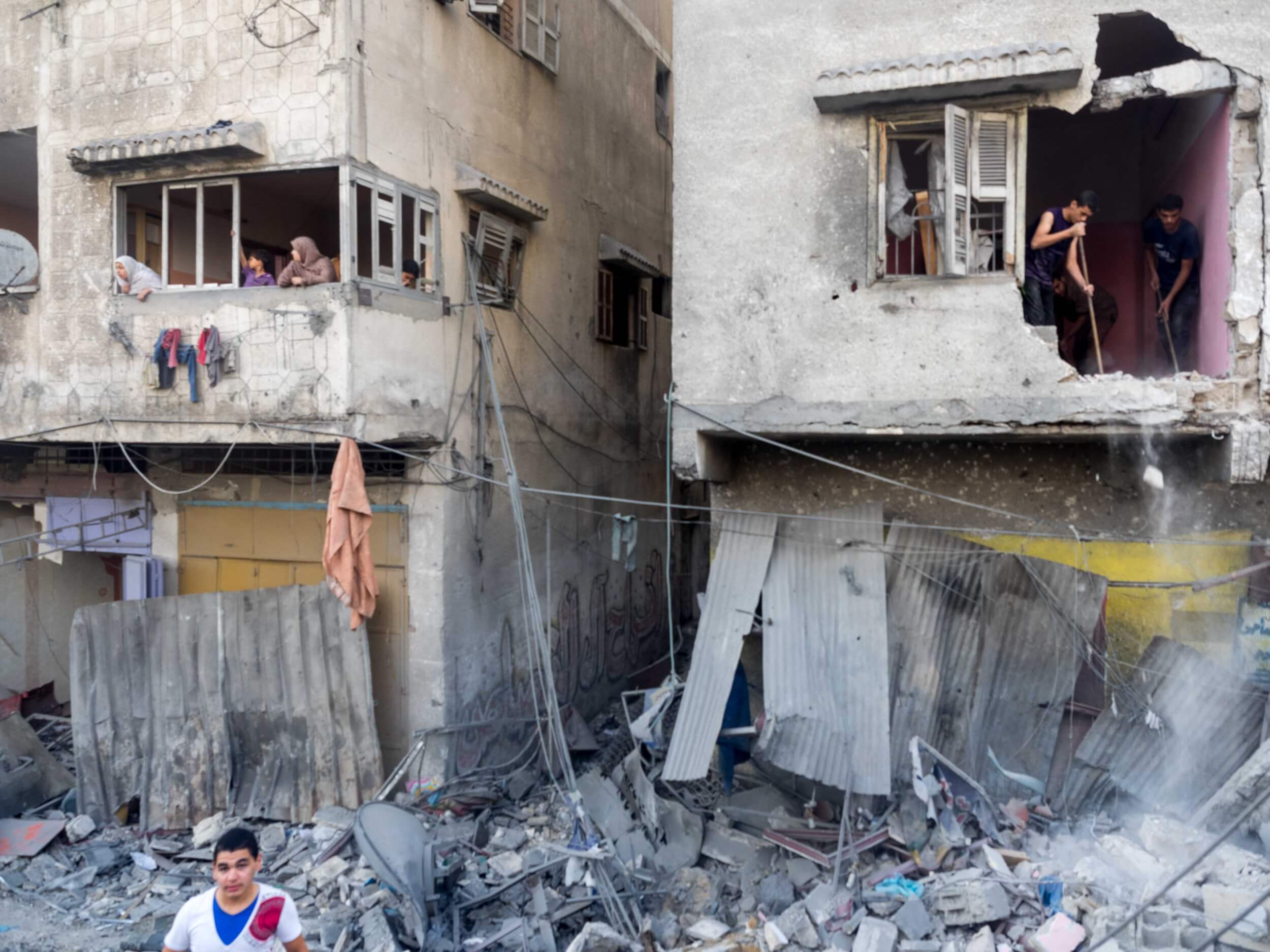
Indeed, the 50-day assault was catastrophic for Palestinians in the besieged Gaza Strip. Israel’s campaign of mass destruction damaged or destroyed at least 75,000 homes, exacerbating existing homelessness from Operation Cast Lead in 2008/2009 by another 108,000. 24 medical facilities were destroyed, including al Wafa hospital, Gaza’s only rehabilitation and geriatric hospital. 22 schools and 73 mosques were destroyed, and two churches were bombed. Israel attacked Gaza’s only power plant, which has since been repaired though is still plagued by fuel shortages. This attack shut down Gaza’s only water treatment plant and sewage treatment facility, resulting in the release of raw sewage into farmland and the Mediterranean Sea. Even prior to the assault, fuel shortages prompted the municipality to instruct Palestinians not to swim in the sea or fish, according to Dr. Nihad Almughany.
Gaza’s fishing and farming industries, already crippled under siege, had been decimated. The destruction of more than 360 factories severely damaged Gaza’s weak industrial economy.
The bombing of these pristine towers during final ceasefire negotiations recalls the US military’s selection of Hiroshima and Nagasaki for nuclear annihilation in World War II, strategically chosen in part because they were untouched. Implementing the principle of “searing into the consciousness” articulated by Moshe Ya’alon, this unprecedented level of destruction struck a final psychological blow, sending an unmistakable message that unless Palestinians in Gaza abandon resistance and accept ghettoization and mass-imprisonment, Israel’s campaign of mass destruction and killing would resume.
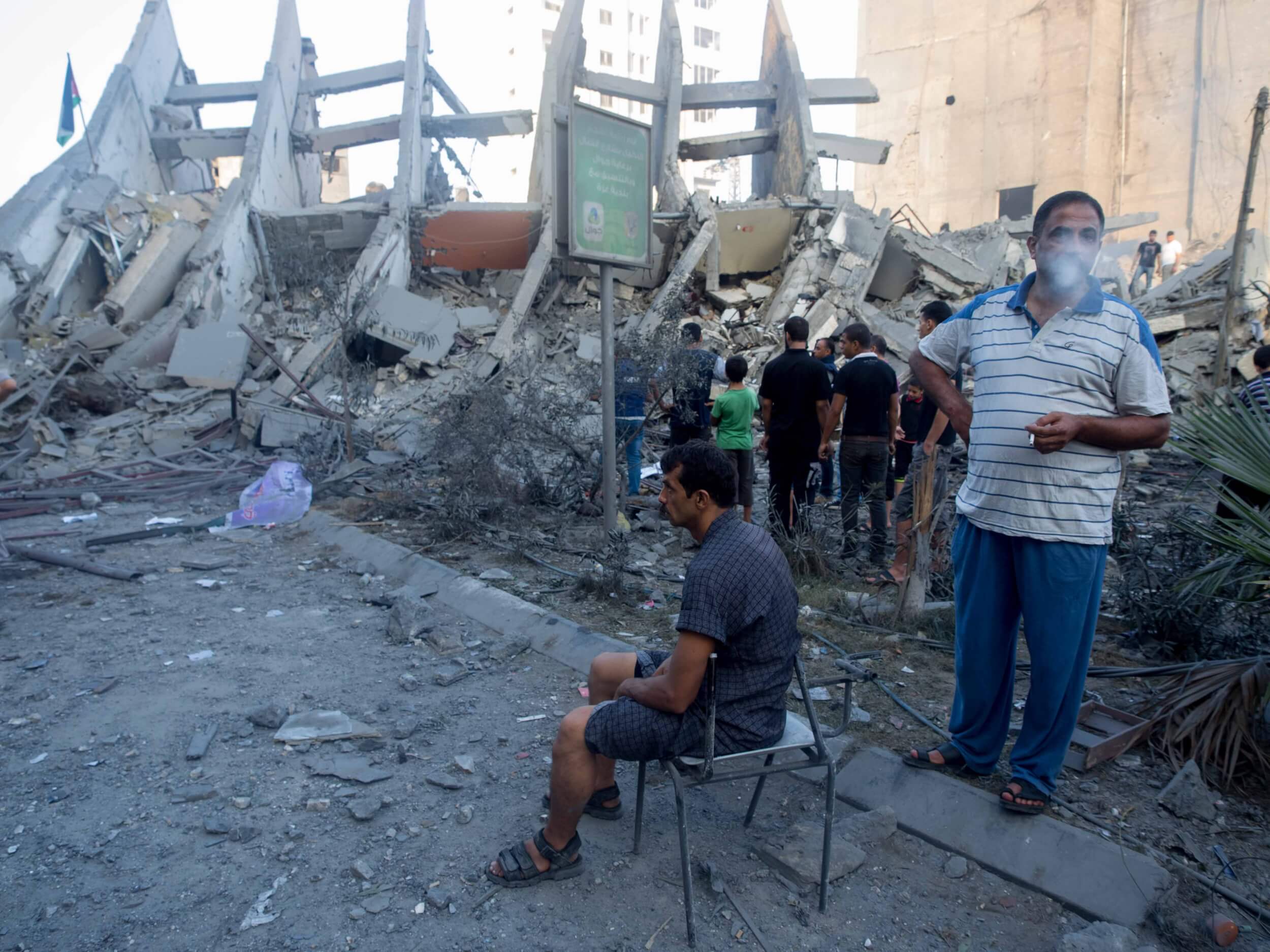
As the bombing ended and the sun rose, I arrived at the base of the Basha Tower, now a pile of smoldering ruins. Many residents of the area had begun to inspect and clean up the damage to their homes and businesses while others stood in a daze. A municipal crew worked efficiently and with obvious experience in this type of situation, using a frontloader to clear the road of rubble. Homes next to the destroyed building had massive holes blown through their outer walls. In normal circumstances, these homes would be uninhabitable and marked condemned. However, the housing crisis throughout the Gaza Strip resulting from years of Israeli attacks left no alternative but to rely on them for all the shelter they could provide.
At the site of the Italian Compound, colorful balls of yarn, parts of dolls, and an array of personal belongings were strewn against the black and grey landscape of desolation. A section of the tower was still standing, and an enormous slab of concrete that used to be the roof hung precariously by rebar hundreds of feet in the air. With apartments stripped of their outer walls, sofas, beds and kitchens cupboards stood exposed, taunting the families who could not reach them.
Oruba Ayesh, a Palestinian refugee from Syria, walked in a daze in front of her adjacent building badly damaged by the Italian Compound’s dramatic collapse. “It’s like a dream,” she stammered. “I feel like I’m sleeping.”
A doctor from Shifa hospital hurried out the door with suitcases to his car. His first home in the northern border area of Beit Hanoun had been destroyed by Israeli shelling, he told me, and the apartment he and his family moved into next to the Italian Compound was irreparably damaged. When I asked him for his name, he replied with dejection, “It doesn’t matter.”

Most residents of the area were too traumatized to speak, I decided to return to the Basha Tower. By afternoon, crews had cleared a massive amount of rubble and traffic was able to pass. Across the street, I met Saleem al Qasas, 27, sitting in a plastic chair and watching crews continue clearing the rubble.
In the middle of the night, al Qasas told me, his neighbor received a phone call from the Israeli military threatening to bomb the neighboring Basha Tower. His family and thousands of others fled to hide behind buildings only a few blocks away. After waiting for hours, at around 4 am, a massive bombardment hit the tower and instantly collapsed it into a burning pile of concrete and mangled rebar.
The neighboring 3-story building that housed the al Qasas family sustained heavy damage. Balconies were blown off and the outer wall that faced the building has four-meter blast holes. Surrounding homes and businesses, including the family’s butcher shop, were heavily damaged or entirely destroyed.
“We have to find new apartments,” said al Qasas. “It’s unsafe to live in these ones. We’re unable to repair these buildings because we are under siege and there are no materials for rebuilding. All of the buildings around here are damaged like that.”
Like so many I met during the war, Al Qasas had experienced Israeli violence not as a sudden burst or terror, but as a continuous, unrelenting process of psychological and physical devastation. His family was twice displaced from Shujaiya, this time during the massive bombardment that left the area uninhabitable and killed close to 200 residents. “They ran away from the shelling and airstrikes,” he recalled. “They are running here to come to a safe place, but there is no such thing!”
As I spoke to al Qasas, a 43-year-old man named Ayman Rajab recognized me as an American. He interrupted with a message directed at the country he and so many I met across the Gaza Strip consider the ultimate culprit in their destruction. “We want to live in dignity with humanity,” he pleaded. “No troops, no guns, no tanks! The American people have responsibility in this. This is a message for American people: Stop this madness immediately!”
27 people including Rajab’s entire family attempted to shelter in his house in Shujaiya throughout the bombardment. After his roof was torn off by Israeli shelling, his family fled to Gaza City. Though his family survived, they were not unscathed. His 16-year-old son had sustained multiple wounds to his neck and was undergoing amputations on his leg and arm as we spoke. Rajab’s eyes welled with tears as he attempted to describe his family’s ordeal. Unable to complete his sentence, he took his youngest son by the hand and walked away.
Later, I accompanied Saleem al Qasas to his battered home. As we walked up a blackened stairwell, he told me that weeks before the bombing of the Basha tower, his home had been targeted by Israeli drones. “The 21st of Ramadan was a day from hell,” he said.
His sisters and their families who had fled the bombardment of Shujaiya were preparing an Iftar meal when two drone strikes hit the top floor apartment. When Saleem al Qasas heard the explosion from his home on a lower floor, he ran up the stairs and found nine family members, all girls and women, blown to pieces. “I found them with their legs and hands missing, and their heads halfway blown off,” he told me. Standing in the destroyed building, he pointed at a blast crater on the floor and told me, “My four nieces were killed right here.”
Saleem Al Qasas’ father walked into the room, and they proceeded to to count the dead on their fingers:
Samar, 3; Arwah, 5; Yasmeen, 7; Israh, 11; Nismah, 12; Lamya, 14; Sumaya, 35; Aliya, 35; and Faysa, 70.
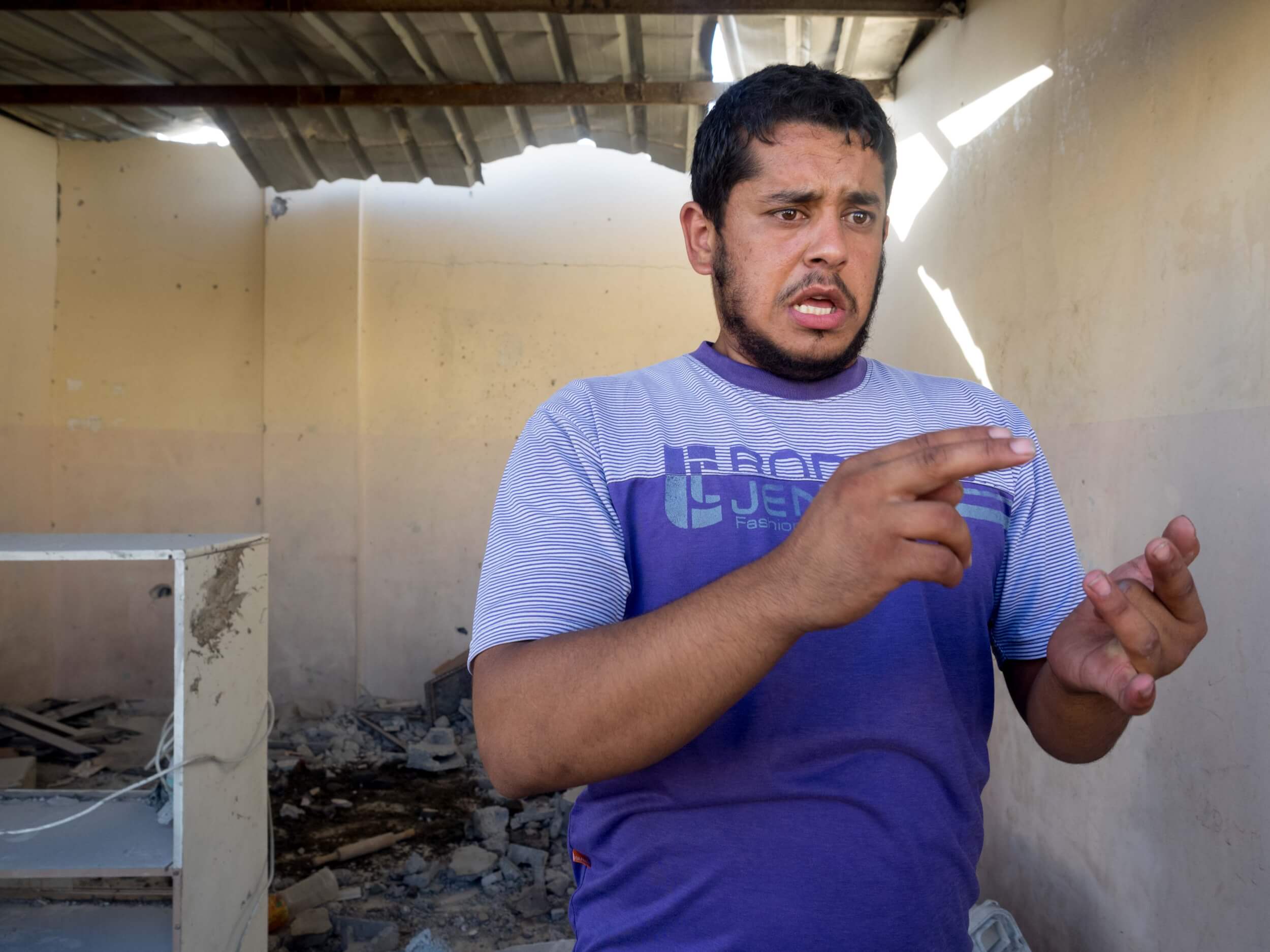
When the explosions from the Israeli munitions pouring down from the sky ignited a fire in the stairwell, Saleem al Qasas’ young cousin, Islam, ran into his apartment to rescue his 15-month-old daughter. A blast nearly killed them, leaving Islam deaf in one ear and badly scorching his infant daughter’s legs.
In Gaza, one disaster is often eclipsed by an even greater catastrophe. Israel’s malevolent fury rises with each assault on the captive population, leaving them to brace for the next assault and wonder what new horrors it will bring them.
Throughout the final weeks of the Israeli onslaught, multiple Gaza residents described Operation Cast Lead to me as a kind of “rehearsal” for the bloodbath of Operation Protective Edge. With the announcement of a final ceasefire, Prime Minister of Israel Benjamin Netanyahu’s approval ratings suddenly plummeted, suggesting that no amount of destruction could satisfy the public’s vengeful wrath.
Considered to be in relatively safe areas away from the decimated border neighborhoods, the destruction of these towers shattered any remaining illusion of security for the residents of the towers. Throughout the entirety of the 51-day assault, they could only watch from balconies and windows as Israeli bombardment massacred thousands and flattened entire neighborhoods. Yet the residents of the towers are now among the homeless, and the destruction of the towers may have previewed what the next Israeli assault will bring.
This week, an international summit raised $5.4 billion to rebuild infrastructure in the Gaza Strip. The summit was hosted in Cairo by the Sisi coup regime which collaborates with Israel to maintain the siege and prevented Palestinians from fleeing during the summer onslaught. The United States pledged $212 million to Palestinians in the Gaza Strip, a fraction of the daily $9.9 million given by the US to Israel, which in part funded the mass-destruction of Gaza.
Fraught with hypocrisy, these post-onslaught donor conferences have become customary. In 2009 and 2012, similar conferences took place, yet failed to address the core issues that enable Israel to continually besiege and periodically slaughter Palestinians in the Gaza Strip. Indeed, Israeli Transportation Minister Israel Katz said that the world is wasting its money and Israel will once again destroy Gaza.


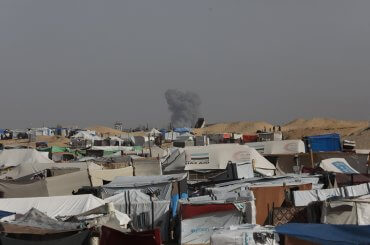
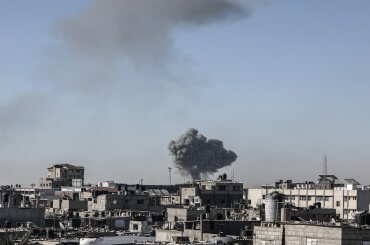
Thanks for this disturbing report. Like Kathleen who commented above, I have not seen or heard anything in the American MSM after the so-called “war” stopped. Just “Israel has a right to defend itself [with weapons supplied by the U.S.]” from politicians and the State department.
We are God,s chosen people and we will bomb you back into the Dark Ages.Our God demands this of us.
Just obeying orders from above —eh.Yours is not to reason why.Yours is just to do or—what ??.
Wakey wakey –up there, they are getting you a seriously bad name and killing your children en masse.
Don,t you care??.
“As I spoke to al Qasas, a 43-year-old man named Ayman Rajab recognized me as an American. He interrupted with a message directed at the country he and so many I met across the Gaza Strip consider the ultimate culprit in their destruction. “We want to live in dignity with humanity,” he pleaded. “No troops, no guns, no tanks! The American people have responsibility in this. This is a message for American people: Stop this madness immediately!””
Ayman Rajab is entirely correct.
Bearing witness and never allowing us to forget is vitally necessary. I thank you very much for your valuable and difficult testimony, Dan Cohen.
RE: “As one missile after another struck the Basha Tower — some military experts have speculated that Israeli forces used US-made 5000-pound GBU bunker busters . . .“ ~ Dan Cohen
MY COMMENT: Using Gaza residential towers for target practice during training for an attack on Iran?
SEE: “Israel Is Set To Receive 5,000 US Bunker Buster Bombs After Delaying Its Attack On Iran”, by Michael B. Kelley, businessinsider.com, Dec. 23, 2012
ENTIRE ARTICLE – http://www.businessinsider.com/the-us-sale-of-5000-bunker-buster-bombs-to-israel-israel-bunker-busters-in-exchange-for-not-striking-iran-2012-12
Thanks for the article. It’s a scandal that the mainstream media has averted its eyes from the horrors of Israel’s destruction of Gaza.
The text came through but the pictures were distorted – stretched in the vertical direction. (I use Firefox).